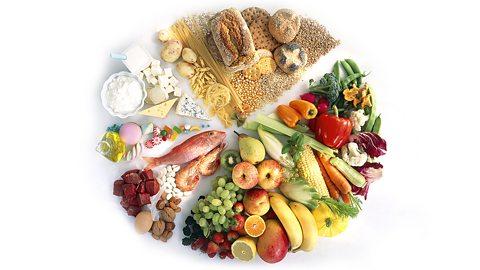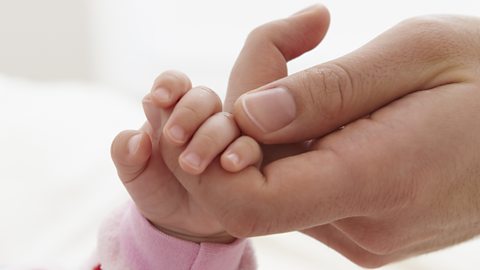The eatwell plate
A balanced diet is a diet in which all the components needed to maintain health are present in appropriate proportions.
The eatwell plate shows the proportions of the different components that should be eaten daily in a well-balanced diet.

A balanced diet should include appropriate proportions of carbohydrate, protein, lipid, vitamins, minerals, water and dietary fibre.
Energy requirements
The amount of energy we need varies. This is due to the following factors:
- age
- activity levels
- pregnancy
Age
The amount of energy we need tends to increase as we approach adulthood.
| Age in years | Daily energy requirement in kJ |
| 0 (newborn) | 2,000 |
| 2 | 5,000 |
| 6 | 7,500 |
| 13 (girl) | 9,000 |
| 13 (boy) | 11,000 |
| 16 (girl) | 9,000 |
| 16 (boy) | 12,000 |
| Age in years | 0 (newborn) |
|---|---|
| Daily energy requirement in kJ | 2,000 |
| Age in years | 2 |
|---|---|
| Daily energy requirement in kJ | 5,000 |
| Age in years | 6 |
|---|---|
| Daily energy requirement in kJ | 7,500 |
| Age in years | 13 (girl) |
|---|---|
| Daily energy requirement in kJ | 9,000 |
| Age in years | 13 (boy) |
|---|---|
| Daily energy requirement in kJ | 11,000 |
| Age in years | 16 (girl) |
|---|---|
| Daily energy requirement in kJ | 9,000 |
| Age in years | 16 (boy) |
|---|---|
| Daily energy requirement in kJ | 12,000 |

The energy needs of adults go down as they age. For example, people in their 50s need about 17 per cent less energy in their diet than people in their 30s.
Activity levels
People who are active tend to need more energy than sedentaryTaking little or no physical activity as part of everyday living. people. For example, an adult office worker might need 10,000 kJ per day, but a manual worker might need 15,000 kJ per day.
Pregnancy
In general, the greater a person’s massThe amount of matter an object contains. Mass is measured in kilograms (kg) or grams (g)., the more energy they need. Men tend to need more energy than women, and a woman’s energy needs increase when she is pregnant. This is mainly because she is carrying extra mass.
The energy content of food
The energy content in a food sample can be measured using simple calorimetryMeasuring the amount of heat given out or taken in by a process, such as the combustion of a fuel..
To carry out this experiment, you need to:
- pour 10 cm3 cold water into a boiling tube
- record the starting temperature of the water
- record the mass of the food sample
- heat the food in a Bunsen flame until it catches fire
- heat the water using the flame from the burning food
- record the final temperature of the water
Calculations
To work out the energy per gram of food transferred to the water, use this equation.
\(\text{energy transferred (J) =}\)
\(~\frac{\text{mass of water (g)}\times 4.2~\text{J/g~}{^\circ\text{C}}\times\text{temperature increase~} {\text{(}{^\circ\text{C)}}}}{\text{mass of food (g)}}\)
Question
Two crisp breads are tested to see which provides the most energy per gram.
0.7 g of crisp bread A is burned and increases the temperature of 10 cm3 of water by 15В°C.
0.5 g of crisp bread B is burned and increases the temperature of 10 cm3 of water by 20В°C.
Using the equation, calculate the energy transferred from each sample. If the answer is more than 1,000 joules, you should express the answer in kilojoules: 1,000 J = 1 kJ.
Note that 1 cm3 of water has a mass of 1 g.
\(\text{energy transferred (J) =}~\frac{\text{mass of water (g)}\times 4.2~\text{J/g~}{^\circ\text{C}}\times\text{temperature increase~} {\text{(}{^\circ\text{C)}}}}{\text{mass of food (g)}}\)
Crisp bread A
\(\frac{10\times4.2\times15}{0.7}{~=~900\text{ J/g~or~}0.9\text{~kJ/g}}\)
Crisp bread B
\(\frac{10\times4.2\times20}{0.5}{~=~1,680\text{~J/g~or~}1.68\text{~kJ/g}}\)
Crisp bread B has the highest energy content.